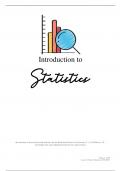Resumen
Summary Introduction to Statistics (424530-B-5)
- Grado
- Institución
- Book
This summary has everything you need to understand the basics of statistics for behavioural sciences: explanations of essential terms, formulas, and step-by-step explanations of how to do specific calculations. Good luck! :)
[Mostrar más]




